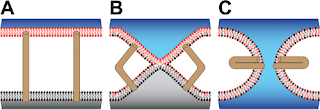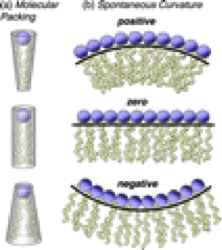Curtis Bustos
Chem 3810-001 BIOCHEMISTRY Name:
KEY
Breakout Problem: Membrane
curvature
1. Match each lipid to its function (signaling, energy
storage & insulation, structural support) and class (glycerolphospholipid,
triacylglycerol, steroid).
Lipid
|
Function
|
Class
|
Cortisol
|
Signaling
|
Steroid
|
Tripalmitoylglycerol
|
Energy storage & insulation
|
Triacylglycerol (TAG)
|
Phosphatidylethanolamine
|
Structure
|
Glycerolphospholipid
|
Curvature of
membranes may result from the shapes and Van der Waals envelopes of lipids. For
example, relative sizes of polar head groups and non-polar fatty acid chains
create a specific size and shape of a surrounding Van der Waals envelope. When
lipids with these characteristics aggregate, their Van der Waals envelope will
contribute toward a specific membrane curvature. Below are some examples of
lipids that contribute toward membrane curvature.
2. Based on the molecular drawings below, all three lipids
seem to have very comparable polar-heads. Why does PE have a smaller polar-head
than PC and LPC?
The methyl-groups that are bonded to
the nitrogen on PC & LPC are larger and have much greater Van der Waals
repulsive forces than the hydrogen atoms that are bonded to the nitrogen on PE.
3. Draw the Van der Waals envelope for each lipid mentioned
previously.
PE PC LPC
4. Identify positive, negative and neutral membrane
curvature from the model below:
5. What lipid(s) contribute toward negative curvature (PC,
LPC, PE)?
PE
6. What lipid(s) contribute toward positive curvature (PC,
LPC, PE)?
LPC
7. What lipid does NOT contribute toward positive or
negative curvature (PC, LPC, PE)?
PC
8.
In addition to membrane curvature, SNAREs facilitate the fusion of membranes by
bringing them together. During this process, induced membrane-curvature may
occur. Identify the membrane curvature of A, B, C from the blue-side of
the membrane.
A = neutral
B = negative curvature toward
the bottom, positive curvature on the top
C = positive curvature
Passage-based questions: membrane
curvature and lipid-protein interactions.
The following is an excerpt taken from a
2012 paper in the Biochemistry Journal of ACS Publications.
Curvature Forces in Membrane Lipid–Protein
Interactions
Department of Chemistry and Biochemistry
and Department of Physics, University of Arizona, Tucson, Arizona 85721, United
States
Biochemistry,
2012, 51 (49), pp 9782–9795
DOI: 10.1021/bi301332v
Publication Date (Web): November 19, 2012
Copyright © 2012 American Chemical Society
Abstract
Membrane biochemists are becoming
increasingly aware of the role of lipid–protein interactions in diverse
cellular functions. This review describes how conformational changes in
membrane proteins, involving folding, stability, and membrane shape transitions,
potentially involve elastic remodeling of the lipid bilayer. Evidence suggests
that membrane lipids affect proteins through interactions of a relatively
long-range nature, extending beyond a single annulus of next-neighbor boundary
lipids. It is assumed the distance scale of the forces is large compared to the
molecular range of action. Application of the theory of elasticity to flexible
soft surfaces derives from classical physics and explains the polymorphism of
both detergents and membrane phospholipids. A flexible surface model (FSM)
describes the balance of curvature and hydrophobic forces in lipid–protein
interactions. Chemically nonspecific properties of the lipid bilayer modulate
the conformational energetics of membrane proteins. The new biomembrane model
challenges the standard model (the fluid mosaic model) found in biochemistry
texts. The idea of a curvature force field based on data first introduced for
rhodopsin gives a bridge between theory and experiment. Influences of bilayer
thickness, nonlamellar-forming lipids, detergents, and osmotic stress are all
explained by the FSM. An increased awareness of curvature forces suggests that
research will accelerate as structural biology becomes more closely entwined
with the physical chemistry of lipids in explaining membrane structure and
function.
Power of Curvature
The idea of a balance of opposing forces
is also embodied in an earlier explanation for the polymorphism of membrane
lipids(123, 138, 139, 146)
using a geometric theory for the self-assembly of amphiphiles.(73, 127) The studies of G. Lindblom
and co-workers(45, 47)
have led to a model in terms of optimal packing of lipids in membranes that is
directly related to the curvature energy.(48)
Such a view exemplifies the chemistry perspective,(147) whereby molecular packing
is quantitatively related to curvature;(148)
either the balance of lamellar and nonlamellar lipids(36) or packing constraints(45, 47) lead to similar
conclusions.(48)
Figure 4a shows a chemical view of
phospholipids in terms of a molecular packing parameter. The packing of lipids
within the aggregate manifests the attractive and repulsive forces acting upon
the polar headgroups and the nonpolar acyl chains.(73) Amphiphiles
with a greater headgroup size relative to that of the chains, such as
gangliosides, lysophospholipids, or single-chain detergents, favor packing into
a conical molecular shape on average (Figure 4a, top). They tend to form
micelles or normal hexagonal HI phases and are analogous to an oil-in-water
dispersion.(123) Lipids with larger headgroups, for instance, phosphatidylcholine
(PC) whose headgroup is methylated versus phosphatidylethanolamine (PE), tend
to pack on average with a cylindrical molecular shape (Figure 4a, middle). They
form a planar lipid bilayer (Figure 2), as abundantly depicted in standard
biochemistry texts. Last, those lipids with relatively small headgroups
compared to the chains, such as PE, prefer to pack into an inverted conical
molecular shape on average (Figure 4a, bottom). They are able to form the
reverse hexagonal HII phase (Figure 2),
which is analogous to a water-in-oil dispersion.(123, 147)
Figure
4. Phospholipid form and function involve molecular packing and spontaneous
membrane curvature. (a) Schematic illustration of the older view characterized
by a molecular packing parameter. Lipids with different headgroups and acyl
chains are inscribed within their corresponding geometrical shapes. Molecular
packing involves the optimal cross-sectional area of the headgroups vs the
projected acyl chain length and the hydrocarbon volume. Either a frustum of a
cone (top or bottom) or average cylindrical lipid shape (middle) accounts for
the diversity of cellular lipids. (b) The new model entails mismatch of the
optimal areas of the headgroups vs the cross-sectional chain area, thus giving
a bending moment for the lipid monolayer. For a membrane bilayer, the
spontaneous curvature compensates for the frustration of the acyl chain
packing. Examples are shown where the spontaneous (intrinsic) monolayer
curvature is positive (toward hydrocarbon), zero, or negative (toward water).
As the optimal headgroup area becomes progressively smaller vis-à-vis the acyl
chains, the spontaneous curvature follows a sequence from positive through zero
to negative. The spontaneous monolayer curvature becomes more negative as the
temperature increases or the level of hydration decreases, giving the sequence
of microstructures in Figure 2 (figure
redrawn from ref 1 courtesy of J. Kinnun).
Shape and Form in Membrane Lipid Function
Perhaps it is worth noting that the
curvatures are not implicit; rather, they correspond to bending of a neutral
(pivotal) plane running beneath the membrane aqueous interface, where the
lateral area remains constant. For example, lipids that form nonlamellar
phases, such as the HII phase, have a negative spontaneous curvature H0. When
they are present in a planar bilayer, there is a mismatch of the geometric mean
curvature H (which is zero) from the spontaneous curvature H0. The
two monolayers are held together by the hydrophobic effect and packing forces.
Curvature mismatch involves the tendency of an individual monolayer of the
bilayer to achieve its natural curvature, which is frustrated by the chain
packing interactions with the other monolayer. Although a bilayer is flat on
average, the two monolayers can still have an inherent tendency to curl. All of
these aspects are discussed in several earlier review articles.(1, 123, 140)
With these basic precepts in mind, the polymorphism
of membrane lipids can now be readily understood by applying the continuum
flexible surface model. The spontaneous (intrinsic)
monolayer curvature (H0) can be positive (toward hydrocarbon),
zero, or negative (toward water), as shown in Figure 4b. When the
optimal headgroup separation exceeds the chains, there is a tendency to curl
toward hydrocarbon; the headgroups have their greatest exposure to water, as in
the case of single-chain surfactants (e.g., lysolipids), as well as glycolipids
and gangliosides, as at the top of Figure 4b.
The positive spontaneous curvature H0 is expressed through formation of small
micelles or the normal hexagonal HI phase (or elongated wormlike micelles), with
the headgroups outside and the chains inside the aggregate (oil-in-water
dispersion) (not shown). By contrast, lipids with smaller headgroups or larger
chains, as in the case of double-chain phospholipids, are less exposed to
water. They favor a more condensed membrane surface, with a smaller interfacial
area per lipid. If the optimal headgroup separation matches the chains, there
is only a small inclination of a monolayer to curl, as in the case of PCs; the
spontaneous curvature H0 is
now approximately zero. The planar lipid bilayer is formed as in the standard fluid
mosaic model; see the middle of Figure 4b.
Finally, lipids with small headgroups are even less hydrated, so they promote a
further condensation of the membrane surface. Because the optimal polar
headgroup separation is less than the chains, the lipid monolayer tends to curl
toward water, e.g., as occurs in unsaturated and polyunsaturated PEs; now there
is a negative spontaneous curvature. Hence, the reverse hexagonal HII (or cubic) phases are formed (see the bottom
of Figure 4b), with the headgroups inside
and the chains outside the lipid aggregate (water-in-oil dispersion).
9. The section entitled “power of curvature” describes how PC,
PE, and LPC (a lysophospholipid) contribute toward membrane curvature. According to the article, does each of
these lipids (PC, LPC, PE) contribute to positive, negative, or neutral
curvature? Does this agree with your reasoning in
questions 5-7 above?
Answers should be the same as
questions 5,6,7 above.
10. Spontaneous (intrinsic) curvature can be identified as
A) Positive (toward hydrocarbon)
B) Neutral
C) Negative (toward water)
D) All of the above terms can be
used to describe intrinsic curvature.


.png)


